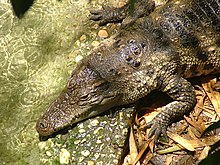The Siamese crocodile (Crocodylus siamensis) is a medium-sized freshwater crocodile native to Indonesia (Borneo and possibly Java), Brunei, East Malaysia, Laos, Cambodia, Myanmar, Thailand and Vietnam. The species is critically endangered and already extirpated from many regions. Its other common names include Siamese freshwater crocodile, Singapore small-grain, and soft-belly.[3]
Phylogeny
[edit] Fossils, formerly referred to as Crocodylus ossifragus
Fossils, formerly referred to as Crocodylus ossifragus Below is a cladogram based on a 2018 tip dating study by Lee & Yates simultaneously using morphological, molecular (DNA sequencing), and stratigraphic (fossil age) data,[4] as revised by the 2021 Hekkala et al. paleogenomics study using DNA extracted from the extinct Voay.[5]
| Crocodylinae |
| ||||||||||||||||||||||||||||||||||||||||||||||||||||||||||||||||||||||||||||||||||||||||||||||||
Characteristics
[edit] Siamese Crocodile – Biblical Zoo
Siamese Crocodile – Biblical Zoo
The Siamese crocodile is a medium-sized, freshwater crocodilian, with a relatively broad, smooth snout and an elevated, bony crest behind each eye. Overall, it is olive-green, with some variation to dark-green.[6] Young individuals measure 1.2 to 1.5 m (3 ft 11 in – 4 ft 11 in) and weigh 6 to 12 kg (13 to 26 lb), growing to a length of 2.1 to 3 m (6 ft 11 in – 9 ft 10 in) and a weight of 40 to 120 kg (88 to 265 lb) as an adult.[7][8] Three individuals measuring 2.12 to 2.63 m (6 ft 11 in – 8 ft 8 in) and weighing 40–87 kg (88–192 lb) had bite force of 2,073–4,577 N (466–1,029 lbf).[9] Large male individuals reach 4 m (13 ft 1 in) and 350 kg (770 lb) in weight.[10]
Distribution and habitat
[edit]Siamese crocodiles occur in a wide range of freshwater habitats, including slow-moving rivers and streams, lakes, seasonal oxbow lakes, marshes and swamps.[11]
Behaviour and ecology
[edit] Siamese crocodile sleeping with its mouth open to release heat
Siamese crocodile sleeping with its mouth open to release heat
Despite conservation concerns, many aspects of C. siamensis life history in the wild remain unknown, particularly regarding its reproductive biology.[11]
Adults feed mainly on fish and snakes, but also eat amphibians and small mammals.[3]
Very little is known about the natural history of this species in the wild, but females build mound-nests constructed from scraped-up plant debris mixed with mud.[6] In captivity, these crocodiles breed during the wet season (April to May), laying between 15 and 50 eggs, which are then guarded until they hatch.[12] After incubation, the female will assist her young as they break out of their eggs and then carry the hatchlings to the water in her jaws.[13]
Pure, unhybridised examples of this species are generally unaggressive towards humans,[14] and there are only four confirmed attacks, none of them fatal. One was defending its young,[15] another was probably defending itself,[16] one was provoked,[17] and the reason for the last is unclear.[18] A fifth attack in 1928 that was probably done by a Siamese crocodile was fatal, with the victim being a child.[19]
